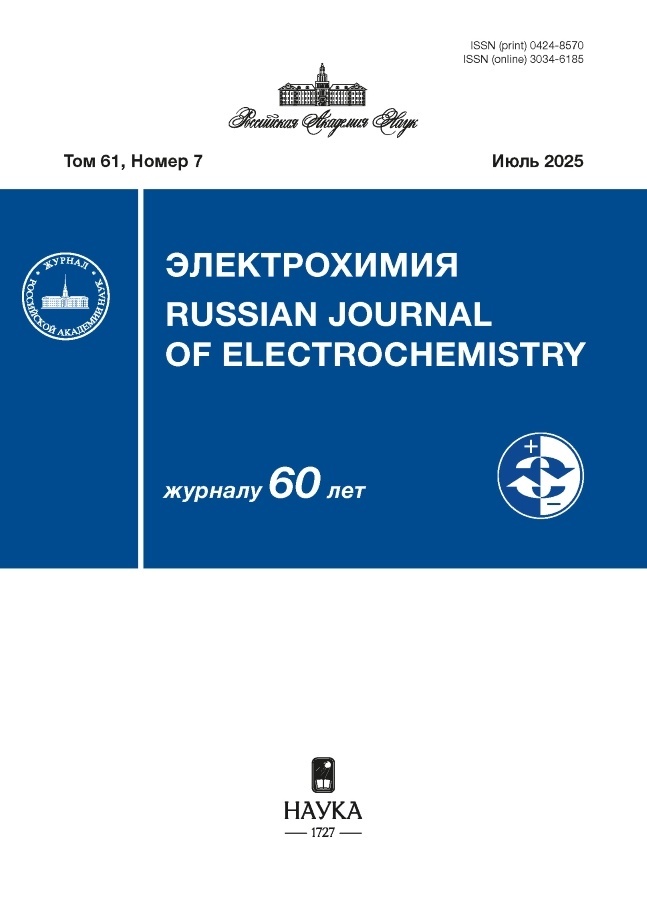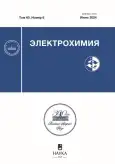Mixed-Alkali Effect in Glasses of Different Classes in the Framework of a Microinhomogeneous-Glass-Structure Model
- Authors: Dobosh A.Y.1, Sokolov I.A.2,3, Khimich N.N.1
-
Affiliations:
- Military Medical Academy named after S.M. Kirov
- Institute of Silicate Chemistry of the Russian Academy of Sciences
- Peter the Great Saint Petersburg Polytechnic University
- Issue: Vol 60, No 6 (2024)
- Pages: 415-429
- Section: Articles
- URL: https://modernonco.orscience.ru/0424-8570/article/view/671326
- DOI: https://doi.org/10.31857/S0424857024060044
- EDN: https://elibrary.ru/PUUPRQ
- ID: 671326
Cite item
Abstract
By example of the silicate glasses with the compositions (33.3 – x) Li2O · xNa2O · 66.7SiO2 and (33.3 – x) K2O · xNa2O · 66.7SiO2 with purely cationic conductance and chalcogenide glasses (Ag–Cu)0.33AsSe1.5 and (Ag–Cu)0.61AsSe1.5 with mixed ionic-electronic conductance, consideration has been given to the describing of the mixed-alkali effect in bimetallic glasses in the framework of a microinhomogeneous-glassstructure model using additive schemes involving concentration dependences of conductivity of monometallic glasses with the monovalent metal content equal to that in the mixed glass. A satisfactory agreement between experimental and calculated data is demonstrated. Herein, in the alkaline silicate glasses the nonlinear variation of the conductivity parameters is connected with the migration of two alkaline cations and sequential replacement of the conductance mainly involving an ion by that involving another ion. In the studied chalcogenide glasses, a similar varying of electrical parameters is connected with the replacement of the majority current carrier upon the equivalent substituting of copper for silver in the glass bulk: the mixed, predominantly ionic conductance is replaced by purely electronic one.
Full Text
About the authors
A. Yu. Dobosh
Military Medical Academy named after S.M. Kirov
Author for correspondence.
Email: alex_dbsh@mail.ru
Russian Federation, Saint Petersburg
I. A. Sokolov
Institute of Silicate Chemistry of the Russian Academy of Sciences; Peter the Great Saint Petersburg Polytechnic University
Email: alex_dbsh@mail.ru
Russian Federation, Saint Petersburg; Saint Petersburg
N. N. Khimich
Military Medical Academy named after S.M. Kirov
Email: alex_dbsh@mail.ru
Russian Federation, Saint Petersburg
References
- Подсвиров, О.Ф., Сидоров, А.И., Чураев, Д.В. Особенности формирования оптических волноводов в силикатном стекле при высокой энергии и дозе электронного облучения. Журн. техн. физики. 2014. Т. 84. № 11. С. 96. [Podsvirov, O.F., Sidorov, A.I., and Churaev, D.V., Specific features of the formation of optical waveguides in silicate glass at high energy and dose of electron irradiation, Technical Physics, 2014, vol. 59, p. 1674.]
- Nolte, S., Will, M., Burghoff, J., and Tuennermann, A., Femtosecond waveguide writing: a new avenue to three-dimensional integrated optics, Appl. Phys. A., 2003, vol. 77, p. 109.
- Dubov, M., Mezentsev, V., Manshina, A.A., Povolotskiy, A.V., Petrov, Y.I., and Sokolov, I.A., Waveguide fabrication in lithium-niobo-phosphate glasses by high repetition rate femtosecond laser: route to non-equilibrium material’s states, Optical mater. express, 2014, vol. 4, no. 6, p. 1197.
- Fernandez, T., Sakakura, M., Eaton, S., Sotillo, B., Siegel, J., Solis, J., and Miura, K., Bespoke photonic devices using ultrafast laser driven ion migration in glasses, Progress in Mater. Sci., 2018, vol. 94, p. 68–113.
- Игнатьев, А.И., Нащекин, А.В., Неведомский, В.М., Подсвиров, О.А., Сидоров, А.И., Соловьев, А.П., Усов, О.А. Особенности формирования наночастиц серебра в фототерморефрактивных стеклах при электронном облучении. Журн. техн. физики. 2011. Т. 81. № 5. С. 75. [Ignatiev, A.I., Nashchekin, A.V., Nevedomsky, V.M., Podsvirov, O.A., Sidorov, A.I., Soloviev, A.P., and Usov, O.A., Formation of silver nanoparticles in photothermorefractive glasses during electron irradiation, Technical Physics, 2011, vol. 56, p. 662.]
- Gedeon, O., Zemek, J., and Jurek, K., Changes in alkali-silicate glasses induced with electron irradiation, J. Non-Cryst. Sol., 2008, vol. 354. no. 12–13, р.1169.
- Markov, V.A., Manshina, A.A., Povolotskiy, A.V., Sokolov, I.A., Vasileva, A.A., and Olshin P.K., Structure of Lithium Niobium Containing Phosphate Glass Used to Create Optical Phase Elements under the Influence of Femtosecond Laser Radiation, Glass Phys. and Chem., 2015, vol. 41, no. 6, p. 572.
- Маньшина, А.А., Поволоцкий, А.В., Курушкин, М.В., Соколов, И.А. Формирование оптических фазовых структур в объеме фосфатных стекол за счет термической диффузии, вызванной воздействием фемтосекундного лазерного излучения. Оптический журн. 2015. Т. 82. № 2. С. 72. [Manshina, A.A., Povolotskiy, A.V., Kurushkin, M.V., and Sokolov, I.A., The formation of optical phase structures in the volume of phosphate glasses by means of thermal diffusion caused by the action of femtosecond laser radiation, J. Optical Technol., 2015, vol. 82, no. 2, p. 120.]
- Markov, V.A., Kurushkin, M.V., Povolotskiy, A.V., and Sokolov, I.A., Electrodiffusion of alkali ions in alkali niobophosphate glasses and glass-forming melts, Inter. J. Appl. Glass Sci., 2019, vol. 10, no. 1, p. 69.
- Markov, V.A., Bozhko, M.A., and Kovalenko, E.K., Ionic Seebeck Effect in Alkali Niobophosphate Glasses, Key Eng. Mater., 2019, vol. 822, p. 818.
- Petrov, A.V., Markov, V.A., and Sokolov, I.A., Electronic Structure and Ionic Transport in Phosphate Glass with Pyrophosphate Structural Elements, Key Eng. Mater. 2019, vol. 822, p. 864.
- Markov, V.A., Kurushkin, M.V. and Sokolov, I.A., Thermodiffusion of alkali ions in alkali niobophosphate glasses, Inter. J. Appl. Glass Sci., 2021, vol. 12, no. 2, p. 222.
- Борисова, З.У. Халькогенидные полупроводниковые стекла. Л.: Наука, 1983. 344 с. [Borisova, Z.U., Chalcogenide semiconductor glasses (in Russian), Leningrad: Nauka, 1983. 344 p.]
- Borisova, Z.U., Glassy semiconductors, New York: Springer US, 2013, 505 p. https://doi.org/10.1007/978-1-4757-0851-6
- Свиридов, С.И. Диффузия в оксидных стеклах и расплавах, СПб.: ВВМ, 2022. 309 с. [Sviridov, S.I., Diffusion in oxide glasses and melts (in Russian), St. Petersburg: BBM, 2022. 309 p.]
- Мюллер, Р.Л. Электрические свойства стекол. Журн. Всесоюз. хим. общ-ва им. Д.И. Менделеева. 1963. Т. 8. № 2. С. 197. [Muller, R.L., Electrical properties of glasses, Russ. J. of the D.I. Mendeleev All-Union Chemical Society, 1963, vol. 8, no. 2, p. 197.]
- Мюллер, Р.Л. Электропроводность стеклообразных веществ, Л.: Изд-во ЛГУ, 1968. 252 с. [Muller, R.L., et al., Electrical conductivity of glassy substances (in Russian), Leningrad: Leningrad University Press., 1968. 252 p.]
- Мюллер, Р.Л. и др. Химия твердого тела, Л.: Изд-во ЛГУ, 1965. 280 с. [Muller, R.L. et al., Solid state Chemistry (in Russian), Leningrad: Leningrad University Press. 1965. 280 p.]
- Шульц, М.М., Мазурин, О.В. Современные представления о строении стекол и их свойствах, Л.: Наука, 1988. 198 с. [Shultz, M.M. and Mazurin, O.V., Modern ideas about the structure of glasses and their properties (in Russian), Leningrad: Nauka, 1988. 198 p.]
- Шахматкин, Б.А., Шульц, М.М. Термодинамические свойства стеклообразующих расплавов системы Na2O-В2O3 в интервале температур 700–1000С. Физика и химия стекла. 1978. Т. 4. № 3. С. 271. [Shakhmatkin, B.A. and Shultz, M.M., Thermodynamic properties of glass-forming melts of the Na2O-B2O3 system in the temperature range 700–1000C, Glass Physics and Chemistry, 1978, vol. 4, no. 3, p. 271.]
- Шахматкин, Б.А., Шульц, М.М. Термодинамические свойства стеклообразующих расплавов системы Na2O-SiO2 в интервале температур 800–1200С. Физика и химия стекла. 1980. Т. 6. № 2. С. 129. [Shakhmatkin, B.A. and Shultz, M.M., Thermodynamic properties of glass-forming melts of the Na2O-SiO2 system in the temperature range 800–1200C, Glass Physics and Chemistry, 1980, vol. 6, no. 2, p. 129.]
- Vedishcheva, N.M. and Wright, A.C., The thermodynamic origin of compositional nanoheterogeneity in glasses, Phys. Chem. Glasses: Eur. J. Glass Sci. Technol. B, 2017, vol. 58, no. 4, p. 150.
- Vedishcheva, N.M. and Polyakova, I.G., Short and intermediate range order in sodium borosilicate glasses: a quantitative thermodynamic approach, Phys. Chem. Glasses: Eur. J. Glass Sci. Technol. B, 2014, vol. 55, no. 6, p. 225.
- Бальмаков, М.Д. Структурные единицы Мюллера в методах расчета свойств стекол по их составу. Физика и химия стекла. 1980. Т. 6. № 2. С. 136. [Balmakov, M.D., Muller's structural units in methods for calculating the properties of glasses based on their composition, Glass Physics and Chemistry, 1980, vol. 6, no. 2, p. 136.]
- Соколов, И.А. Стеклообразные твердые электролиты. Структура и природа проводимости. СПб.: Изд-во Политехн. ун-та, 2010, 392 с. [Sokolov, I.A., Glassy solid electrolytes. Structure and the nature of conductivity (in Russian), St. Petersburg: Polytechnic University Press, 2010. 392 p.]
- Pronkin, A.A., Murin, I.V., and Sokolov, I.A., Development of the R.L. Muller Model of the Microheterogeneous Structure of Glass and Its Application for Various Glass Types, Glass Phys. and Chem., 2015, vol. 41, no. 1, p. 35.
- Нараев, В.Н. Влияние “воды” на физико-химические свойства стекол. Физика и химия стекла. 2004. Т. 30. № 5. С. 499. [Naraev, V.N., The Influence of Water on the Glass Properties, Glass Phys. and Chem., 2004, vol. 30, no. 1, p. 367.]
- Пронкин, А.А. Об аддитивной электропроводности полищелочных силикатных стекол. Вестн. ЛГУ, сер. Физика, химия. 1968. № 10. С. 148. [Pronkin, A.A., On the additive electrical conductivity of polyalkaline silicate glasses, Vestnik Leningrad State University “Physics, chemistry”, 1968, no. 10, p. 148.]
- Пронкин, А.А. Числа переноса и подвижность щелочных ионов в двущелочных стеклах состава (Меʹ2О-Меʺ2О)‧2SiO2. Физика и химия стекла. 1979. Т. 5. № 5. С. 634. [Pronkin, A.A., Transport numbers and mobility of alkali ions in double-alkali glasses of the composition (Meʹ2O-Meʺ2O)‧2SiO2, Glass Phys. and Chem., 1979, vol. 5, no. 5, p. 634.]
- Мазурин, О.В., Стрельцина, М.В., Швайко-Швайковская, Т.П. Справочник. Свойства стекол и стеклообразующих расплавов. Т. 1. Стеклообразный кремний и двухкомпонентные силикатные системы, Л.: Наука, 1973. 444 с. [Mazurin, O.V., Streltsina, M.V., and Shvayko-Shvaykovskaya, T.P., Handbook. Properties of glasses and glass-forming melts. Vol. 1. Glassy silicon and two-component silicate systems (in Russian), Leningrad: Nauka, 1973. 444 p.]
- Bochagina, E.V., Klinkov, V.A., Markov, V.A., Polyakova, V.V., and Sokolov, I.A., The nature of DC conductivity and structural features of glasses of the Ag – As – Se system as materials for photonics and integral optics, Mater. Phys. and Mechan., 2021, vol. 47, р. 344.
Supplementary files














